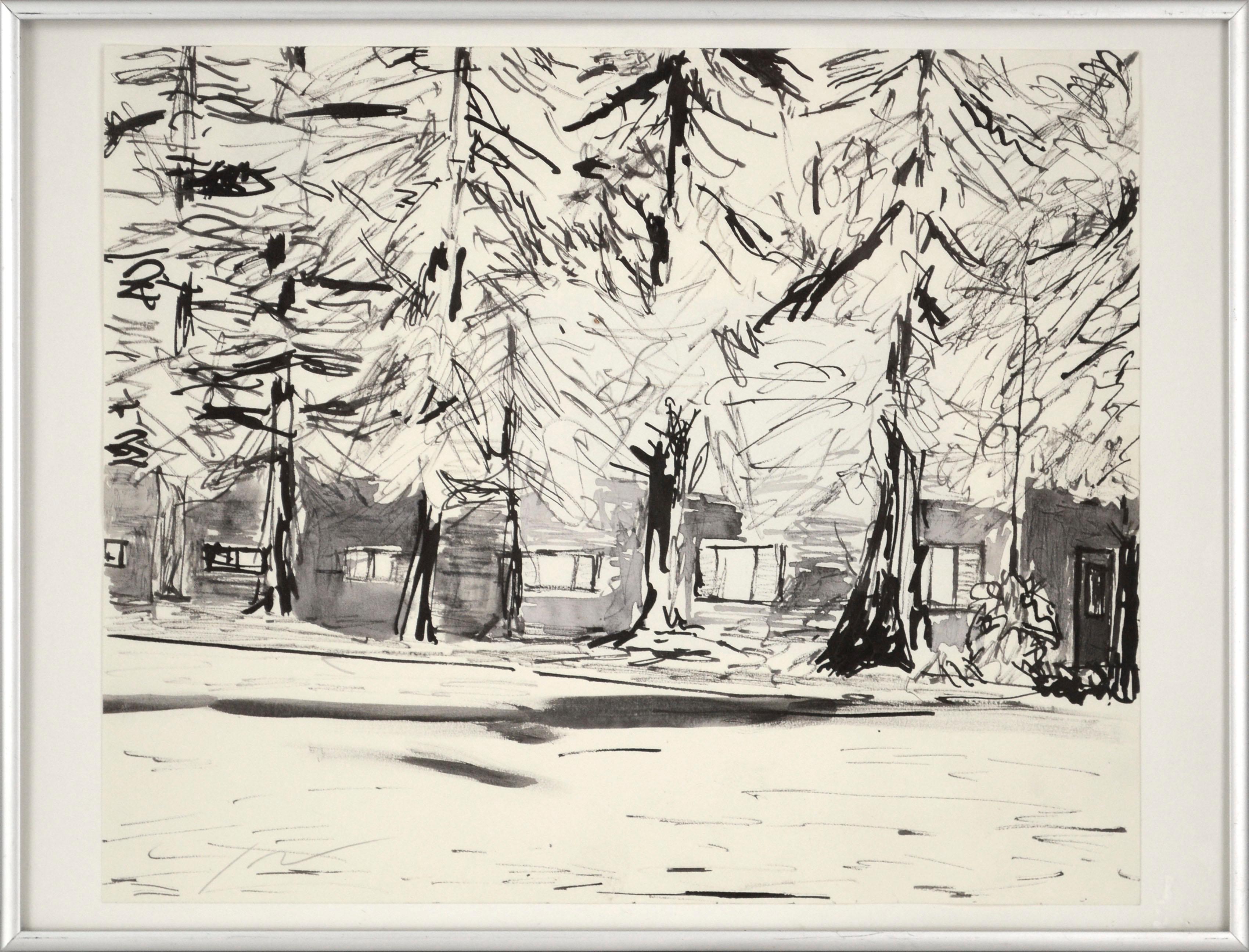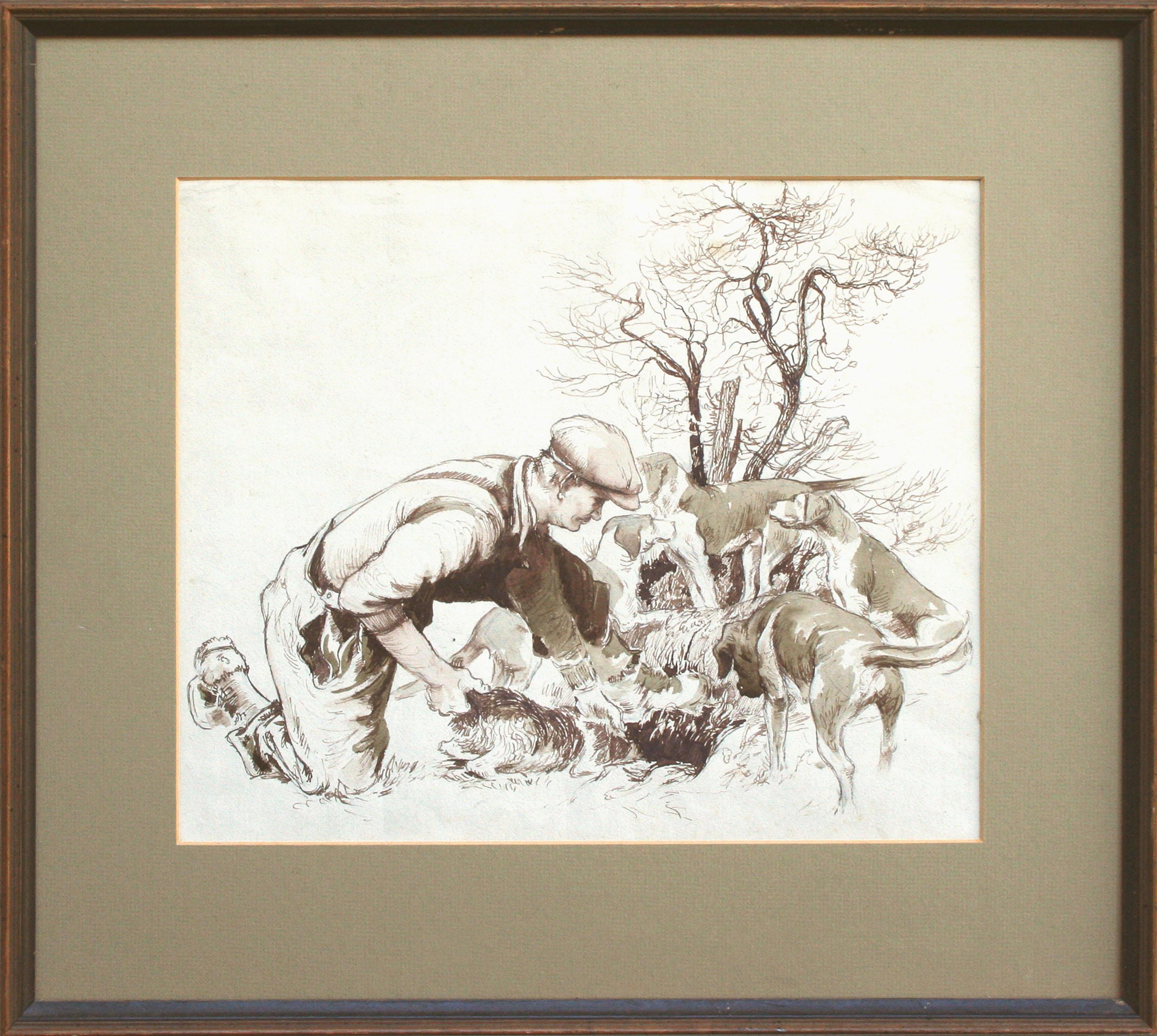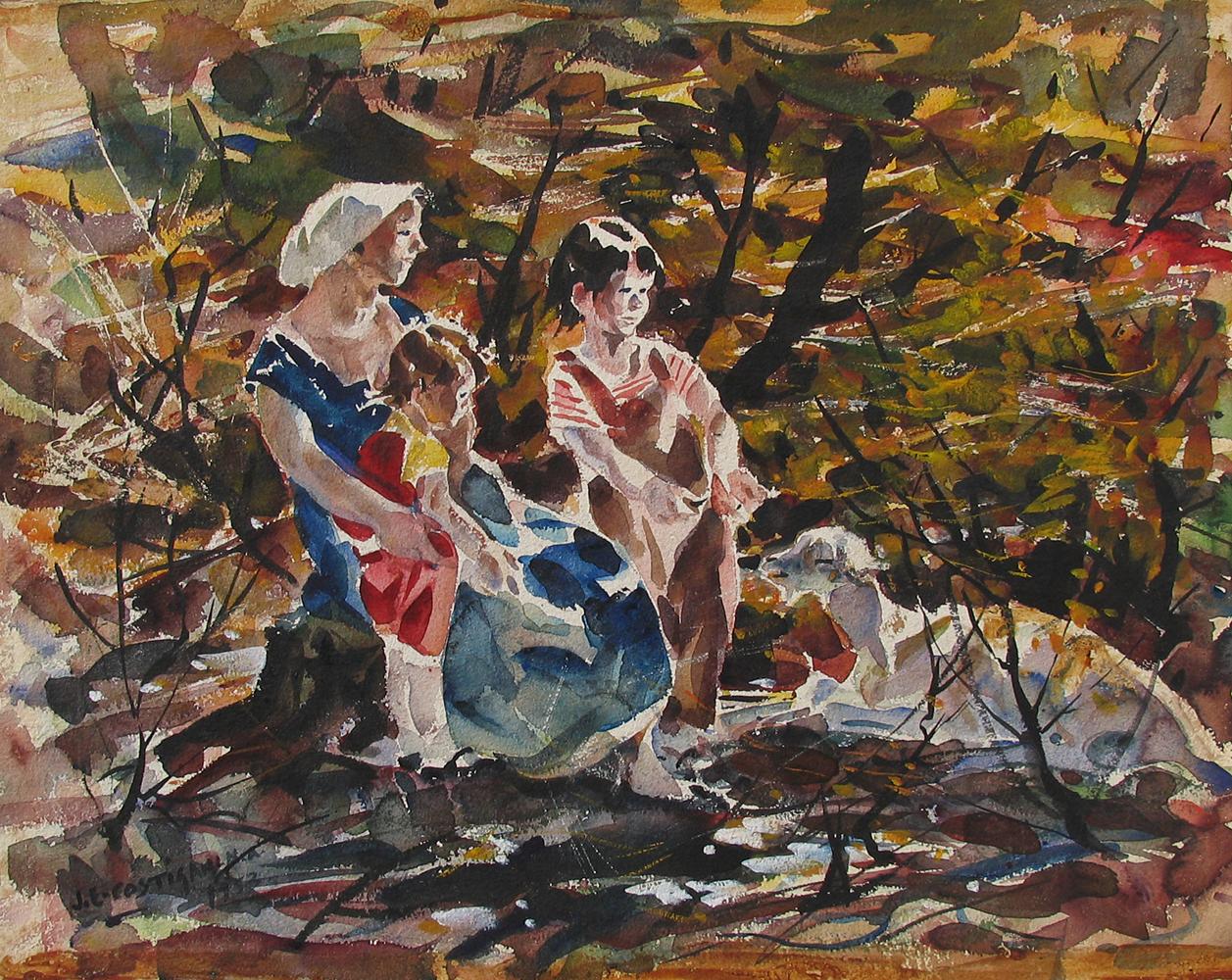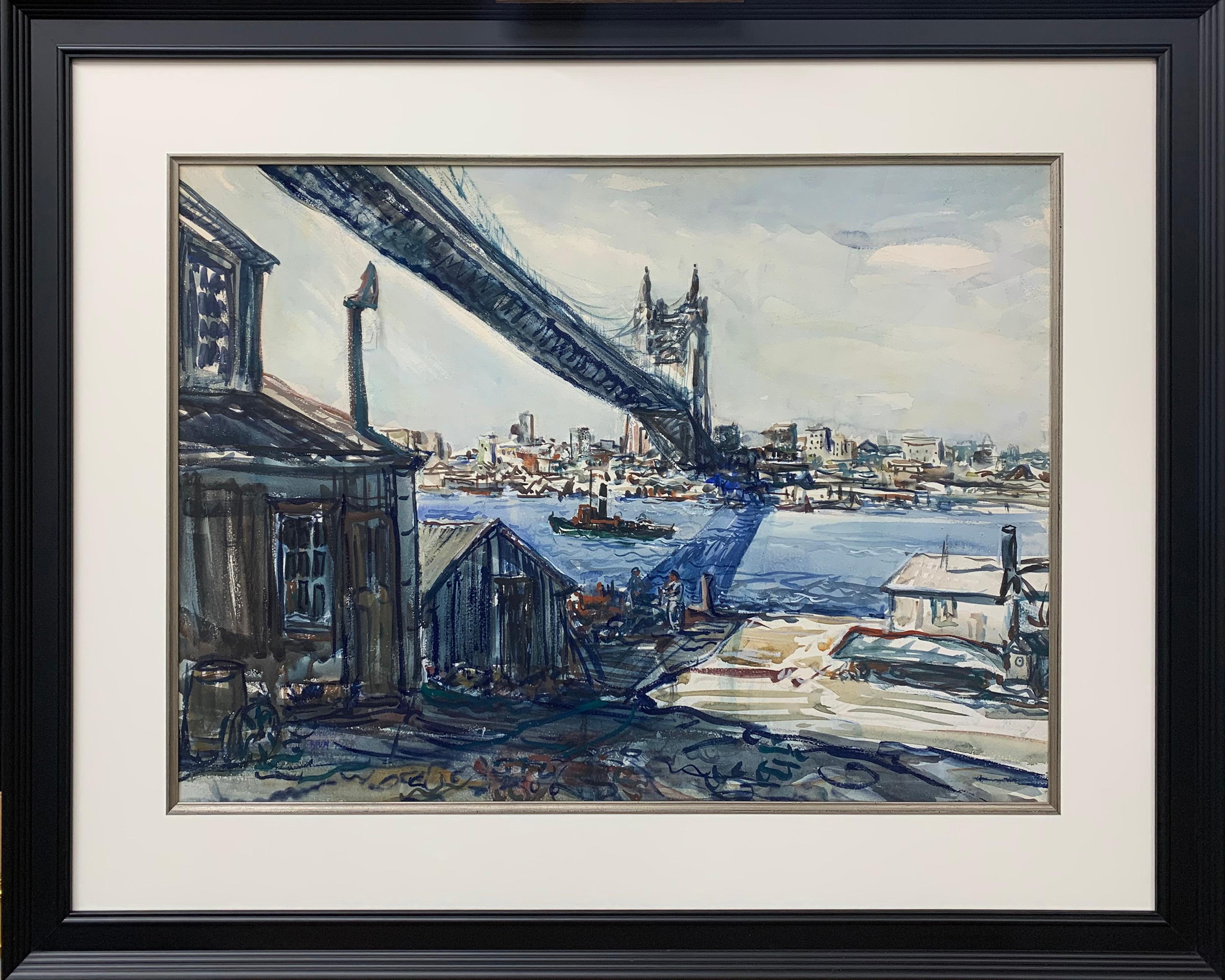Items Similar to Mid Century Modern Farmhouse Landscape in Watercolor and Ink on Paper
Want more images or videos?
Request additional images or videos from the seller
1 of 12
Robin Gay McClineMid Century Modern Farmhouse Landscape in Watercolor and Ink on Papermid 20th Century
mid 20th Century
About the Item
Mid Century Modern Farmhouse Landscape in Watercolor and Ink on Paper
Bright, modern landscape by Robin Gay McCline (American, 1928-2008). A line of trees and buildings runs across the center of the composition. In the foreground, there are patches of green, tan, and magenta ground. The sky above is comprised of patches of blue, white, and grey, divided by lines.
Signed "Robin Gay McCline" in the lower right corner.
Presented in a wormwood frame with an off-white mat.
Frame size: 19"H x 27.5"W
Image size: 11.75"H x 21.5"W
Robin McCline (American, 1928-2008) was born in Fresno, CA. As a young child, McCline suffered an injury that required him to be taught from home for two years – it was during this time that he began drawing and painting. He attended Fresno State College and then UC Berkeley, where he received his degree in Architecture. McCline later taught architectural drafting at Fresno City College for 19 years and was the president of the Fresno Arts Center, as well as a member of the California Watercolor Society and the American Institute of Architects.
2000 – Kings Art Center, Hanford, CA
1984 – Retrospective Exhibit, Art Space Gallery, Fresno, CA
1984 – Covier Gallery, Fresno, CA
1980 – Guarantee Savings, Fresno, CA
1979 – Solo Show, Dick Monroe gallery, Fresno, CA
1979 – Sequoia Savings and Loan, Fresno, CA
1954 – 2nd, 3rd, Hon. Mention, Fresno Art League Show, Fresno, CA
- Creator:Robin Gay McCline (American)
- Creation Year:mid 20th Century
- Dimensions:Height: 19 in (48.26 cm)Width: 27.5 in (69.85 cm)Depth: 1 in (2.54 cm)
- Medium:
- Movement & Style:
- Period:
- Condition:
- Gallery Location:Soquel, CA
- Reference Number:
About the Seller
4.9
Platinum Seller
These expertly vetted sellers are 1stDibs' most experienced sellers and are rated highest by our customers.
Established in 1986
1stDibs seller since 2014
2,519 sales on 1stDibs
Typical response time: <1 hour
- ShippingRetrieving quote...Ships From: Soquel, CA
- Return PolicyA return for this item may be initiated within 14 days of delivery.
More From This SellerView All
- Cabin in the Woods, India Ink Forest Landscape with Redwood TreesBy Michael PaukerLocated in Soquel, CAIndia ink and watercolor landscape in black done with expressive, linear brushstrokes featuring tall redwood trees with cabin windows peaking through the ...Category
2010s American Impressionist Landscape Drawings and Watercolors
MaterialsPaper, Watercolor, India Ink
- On the Hunt - Early 20th Century Figurative Drawing with DogsLocated in Soquel, CAFigurative ink and wash drawing of beagles and a terrier leading the hunter to the quarry by an unknown artist (American, 20th Century). Unsigned. Displayed in a rustic black and bro...Category
1930s American Impressionist Figurative Drawings and Watercolors
MaterialsInk, Paper, Watercolor
- "Mountain Climbers" - Mountain Landscape in Watercolor on PaperLocated in Soquel, CA"Mountain Climbers" - Mountain Landscape in Watercolor on Paper Serene mountain landscape by Margie Westcott (American, 1931-2018). The viewer stands...Category
Late 20th Century American Impressionist Landscape Drawings and Watercolors
MaterialsPaper, Watercolor
- Captiva Island, Florida - Beach Landscape in Watercolor on PaperLocated in Soquel, CACaptiva Island, Florida - Beach Landscape in Watercolor on Paper Detailed watercolor of a Florida island beach by unknown artist "Dowst" (American, 20th Century). Scrub brush and ot...Category
1960s American Impressionist Landscape Drawings and Watercolors
MaterialsPaper, Watercolor
- "Shenandoah Valley" - Rural California Landscape in Watercolor on PaperLocated in Soquel, CA"Shenandoah Valley" - Rural California Landscape in Watercolor on Paper Idyllic country landscape by California artist Alice M. Duke (American, 1921-2012). Two large brown-red barns sit at the edge of a glassy body of water. They are surrounded by towering dark green trees, which are reflected in the water along with the barns. Titled "Shenandoah Valley"; California Shenandoah Valley AVA is an American Viticultural Area that includes portions of Amador County and El Dorado County, California, United States. It is a sub-region of the Sierra Foothills. titled "shenandoah Valley" and monogrammed AC #25 on mat verso verso. (we have two others with signed labels "Alice Duke" and initialed AC #23 & AC #24 by this artist) Presented in a vintage frame with a double mat. Frame size: 16.75"H x 20.75"W Image size: 10"H x 14"W Duke, Alice (American, 1921-2012 was an artist from Jackson, California. She was a student of Dorner Schueler. A member and exhibitor with the Central Coast Art League. Memberships: Founding member, Gallery 10. Central California Art League Member, Northern California Arts. Member, Society of Western Artist Shows and Awards: 1999 - Gallery 10, Sutter Creek, CA 1986 - (1st Place, Watercolors) Sonoma Valley Art Center, Sonoma, CA 1985 - (Hon. Mention, Watercolors) Sonoma Valley Art Center, Sonoma, CA 1982 - Sunshine Art...Category
1960s American Impressionist Landscape Drawings and Watercolors
MaterialsPaper, Watercolor
- "A Shady Runlet" Stream in Fall New Jersey Watercolor 1878Located in Soquel, CA"A Shady Runlet" Stream in Fall New Jersey Watercolor 1878 A rare and exceptional watercolor of two ladies viewing a New Jersey stream in fall by William C. Bauer (American, 1856- 1...Category
1870s American Impressionist Landscape Drawings and Watercolors
MaterialsPaper, Watercolor
You May Also Like
- Mother and Children watercolor painting by John E. CostiganBy John CostiganLocated in Hudson, NYPainting measures 22" x 28" and framed 26" x 32" x 2" Hand-signed "J.E. Costigan NA 1952" lower left. About this artist: John Costigan was a self-taught painter distinguished by h...Category
Mid-20th Century American Impressionist Figurative Drawings and Watercolors
MaterialsPaper, Watercolor
- The Rapids (Maine)By John WhorfLocated in Provincetown, MAJohn Whorf, born in 1903, was a talented, opinionated artist who achieved great success at a young age. Encouraged by his artistic father, Whorf studied briefly during his early te...Category
Early 20th Century American Impressionist Landscape Drawings and Waterco...
MaterialsPaper, Watercolor
- Pennsylvania Farmhouse, American Impressionist Landscape, Watercolor on PaperBy Albert Van Nesse GreeneLocated in Doylestown, PA"Pennsylvania Farmhouse" is a beautiful spring landscape with rolling hills and countryside farmhouses. The watercolor on paper is painted by American Impressionist Albert Van Nesse Greene. The painting is a 14" x 19" watercolor on paper, matted, framed under glass, and signed "A V Greene...Category
Early 20th Century American Impressionist Landscape Drawings and Waterco...
MaterialsWatercolor, Archival Paper
- 59th Street Bridge, Pennsylvania Impressionist Watercolor CityscapeBy Walter Emerson BaumLocated in Doylestown, PA"59th Street Bridge" is a 22" x 30" watercolor on paper cityscape of the Brooklyn Bridge and city skyline, painted by Pennsylvania Impressionist and...Category
1940s American Impressionist Landscape Drawings and Watercolors
MaterialsWatercolor, Archival Paper
- “The Mountains of St. Maurice”By Dodge MacknightLocated in Southampton, NYOriginal watercolor on archival paper of the mountains of Saint Maurice in Switzerland by the well known American artist, Dodge MacKnight. Signed lower left and titled and dated 189...Category
1890s American Impressionist Landscape Drawings and Watercolors
MaterialsWatercolor, Archival Paper
- "Train Station, " Max Kuehne, Industrial City Scene, American ImpressionismBy Max KuehneLocated in New York, NYMax Kuehne (1880 - 1968) Train Station, circa 1910 Watercolor on paper 8 1/4 x 10 1/4 inches Signed lower right Provenance: Private Collection, Illinois Max Kuehne was born in Halle, Germany on November 7, 1880. During his adolescence the family immigrated to America and settled in Flushing, New York. As a young man, Max was active in rowing events, bicycle racing, swimming and sailing. After experimenting with various occupations, Kuehne decided to study art, which led him to William Merritt Chase's famous school in New York; he was trained by Chase himself, then by Kenneth Hayes Miller. Chase was at the peak of his career, and his portraits were especially in demand. Kuehne would have profited from Chase's invaluable lessons in technique, as well as his inspirational personality. Miller, only four years older than Kuehne, was another of the many artists to benefit from Chase's teachings. Even though Miller still would have been under the spell of Chase upon Kuehne's arrival, he was already experimenting with an aestheticism that went beyond Chase's realism and virtuosity of the brush. Later Miller developed a style dependent upon volumetric figures that recall Italian Renaissance prototypes. Kuehne moved from Miller to Robert Henri in 1909. Rockwell Kent, who also studied under Chase, Miller, and Henri, expressed what he felt were their respective contributions: "As Chase had taught us to use our eyes, and Henri to enlist our hearts, Miller called on us to use our heads." (Rockwell Kent, It's Me O Lord: The Autobiography of Rockwell Kent. New York: Dodd, Mead and Co., 1955, p. 83). Henri prompted Kuehne to search out the unvarnished realities of urban living; a notable portion of Henri's stylistic formula was incorporated into his work. Having received such a thorough foundation in art, Kuehne spent a year in Europe's major art museums to study techniques of the old masters. His son Richard named Ernest Lawson as one of Max Kuehne's European traveling companions. In 1911 Kuehne moved to New York where he maintained a studio and painted everyday scenes around him, using the rather Manet-like, dark palette of Henri. A trip to Gloucester during the following summer engendered a brighter palette. In the words of Gallatin (1924, p. 60), during that summer Kuehne "executed some of his most successful pictures, paintings full of sunlight . . . revealing the fact that he was becoming a colorist of considerable distinction." Kuehne was away in England the year of the Armory Show (1913), where he worked on powerful, painterly seascapes on the rocky shores of Cornwall. Possibly inspired by Henri - who had discovered Madrid in 1900 then took classes there in 1906, 1908 and 1912 - Kuehne visited Spain in 1914; in all, he would spend three years there, maintaining a studio in Granada. He developed his own impressionism and a greater simplicity while in Spain, under the influence of the brilliant Mediterranean light. George Bellows convinced Kuehne to spend the summer of 1919 in Rockport, Maine (near Camden). The influence of Bellows was more than casual; he would have intensified Kuehne's commitment to paint life "in the raw" around him. After another brief trip to Spain in 1920, Kuehne went to the other Rockport (Cape Ann, Massachusetts) where he was accepted as a member of the vigorous art colony, spearheaded by Aldro T. Hibbard. Rockport's picturesque ambiance fulfilled the needs of an artist-sailor: as a writer in the Gloucester Daily Times explained, "Max Kuehne came to Rockport to paint, but he stayed to sail." The 1920s was a boom decade for Cape Ann, as it was for the rest of the nation. Kuehne's studio in Rockport was formerly occupied by Jonas Lie. Kuehne spent the summer of 1923 in Paris, where in July, André Breton started a brawl as the curtain went up on a play by his rival Tristan Tzara; the event signified the demise of the Dada movement. Kuehne could not relate to this avant-garde art but was apparently influenced by more traditional painters — the Fauves, Nabis, and painters such as Bonnard. Gallatin perceived a looser handling and more brilliant color in the pictures Kuehne brought back to the States in the fall. In 1926, Kuehne won the First Honorable Mention at the Carnegie Institute, and he re-exhibited there, for example, in 1937 (Before the Wind). Besides painting, Kuehne did sculpture, decorative screens, and furniture work with carved and gilded molding. In addition, he designed and carved his own frames, and John Taylor Adams encouraged Kuehne to execute etchings. Through his talents in all these media he was able to survive the Depression, and during the 1940s and 1950s these activities almost eclipsed his easel painting. In later years, Kuehne's landscapes and still-lifes show the influence of Cézanne and Bonnard, and his style changed radically. Max Kuehne died in 1968. He exhibited his work at the National Academy of Design, the Art Institute of Chicago, the Carnegie Institute in Pittsburgh, the Memorial Art Gallery of the University of Rochester, and in various New York City galleries. Kuehne's works are in the following public collections: the Detroit Institute of Arts (Marine Headland), the Whitney Museum (Diamond Hill...Category
1910s American Impressionist Landscape Drawings and Watercolors
MaterialsPaper, Watercolor





